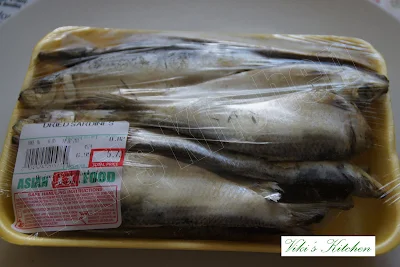Karuvattu kulambu (Tamil), translated as dry fish curry is a popular curry made during the month of Aadi (mid July to mid August) in almost all the non vegetarian families of Tamilnadu. The devotees of Goddess Amman will gather together on a Sunday of that Tamil month and make this kulambu along with keppai kool(zh) and make an offering.Then that meal will be shared among the relatives and friends as holy food. I thought it will be apt to make a post on that famous 'Chennai Karuvadu kuzhambu' in this month.
Memories: While in Chennai we had / have a friendly neighborhood family. The lady of the house is my best friend till now and she is always praised for her caring nature to every one who comes to her. She usually celebrates this whole month with lot of poojas and we enjoy them together. She would bring a big share for all of us during that time. Also, I used to make this for my father-in law who is a big fan of this:)
Vegetarians can check out my
mochai kottai kulambu:)
 |
| Dried sardines, I got from an Asian grocery stores. | |
I used dried sardine (salai karuvadu / mathi meen karuvadu).Kulambu won't need much dry-fish, a little will bring out a lot of flavor. Being born and brought up in a land with abundant fish, I never thought dry-fish could be in this huge demand. Frankly speaking , many people in my home town won't admit their taste for this dry-fish in public. But we can't hide this flavor inside a house after preparing it:) Many Asian cuisines include dried fish in the sauce, noodles etc , but getting a decent one is a big challenge. As we all know the price of a commodity varies with demand, this understated Asian dried sardine is in a fairly high price here:)
Ingredients:
Dried Sardine - 4
(or) nethili karuvadu - 15 (or) any karuvadu piece - 150 gm.
Mochai kottai / val dhal - 1 cup
Baby Brinjal - 4
Drumstick (vegetable) - 1
Tomato - 2
Tamarind - small lime size
mustard - 1/2 tsp
fenugreek seeds- 1/2 tsp
curry leaves - 1 sprig
oil - 1 tbsp
asafoetida - 1 pinch
Red chilli powder - 1 tbsp
coriander powder - 4 tsp
turmeric powder - 1/4 tsp
water - 2 cups
salt - 2 tsp
To grind:
shredded coconut - 1/2 cup
shallot (nattu vengayam) - 5
cumin - 1 tsp
Preparation:
(If you are using the fresh beans then just start from the method.
otherwise go for pre soaking.)
Dry roast the mochai kottai, till u see dark spots on the outer layer and a nice aroma.
Then rinse it with water twice. Add water till it gets well immersed. Soak overnight or an hour.
Pressure cook for 3 whistles.
(we can cook it in stove top also, but it will take an hour).
Always store the dry-fish in freezer for safety.
De-freeze it by putting in water for 10 minutes. Scrap the tiny scales with a knife and remove them along with fins and intestine.
Wash well till the water runs clear. No need to slice it. Keep aside.
Method:
Cut drumstick into 2 inch pieces and make a small slit in each piece.
Cut the eggplant / brinjal into small pieces.
Soak the tamarind in hot water and extract juice using 2 cups of water.
Heat oil in a pan.
Crackle mustard seeds , add fenugreek seeds , curry leaves and asafoetida.
Then add the chopped tomato and fry till becomes mushy.
Then add the tamarind juice, salt, chilly powder, Turmeric, coriander powder.
Now add the cut vegetables with 2 cups water (use drained water from the cooked dal) and cook till the vegetables become tender.
Then add the cooked val dhal (mochai kottai) and bring it to a boil.
Put the masala paste and bring it to a boil. Then put the cleaned dry-fish and cook closed. Let it boil for 10 minutes and switch off.
Karuvattu kulambu is ready!
Serving suggestions:
The above can be served for 5 people.
This curry will stay fresh for 2 days in room temperature.
This is commonly served as side dish for keppai / kelviragu kool (finger millet porridge).
Otherwise, Serve hot with steamed rice and any vegetable side dish or with egg omlete.
Good with idly, dosa too.





